Sometimes curiosity gets the better of us. How much did the neighbor pay for that car? Did I get a better deal than my cousin on my mobile data plan? Will squirrels bite?
Or maybe you wonder how much your coworker paid for that Philodendron patriciae. You heard they are expensive, but was it more than your prized Monstera deliciosa ‘Albo Variegata’?
Houseplant prices for hard-to-find or rare specimens can vary as much as the stock market in November. What is in vogue this month is stale the next. The latest hype is a huge driver of demand for the most fashionable houseplants, and higher demand drives higher prices for a time. Influencer social media accounts can cause a flash demand. Magazine features or layouts will inspire well-to-do phytomaniacs to spare no expense to add a new specimen to their collection. With a rise in demand comes a rise in production, and plant entrepreneurs undertake to ramp up propagation. Eventually, either demand falls or the market is flooded and prices fall.
A one-off sale of a plant that is so rare no one else will ever find one for sale is entertaining in a tabloid kind of way, but not quite what we were looking for. Therefore, any attempt to assemble a list of the most expensive indoor plants needs a few boundaries.
The Method
We started with the strict requirement that any plant which makes it to the finals for consideration on our “Most Expensive Houseplants” list must be a current high-roller. Being at the top of the list two years ago won’t cut it. To earn a spot on our list, the high prices must be for plants selling now.
Demand, a.k.a. popularity, drives price and is an indicator of sustained interest, which means that a plant may continue to sell for top dollar. If no one has heard of the plant, but a single example sold for big bucks because it is hard to find in that size or shape, it is not likely the species has enough staying power to earn a spot on the list. High prices due only to extreme rarity are not what we are looking for.
Is it unique, odd, rare, or otherwise distinguishable? Anything can suffer a temporary price hike due to a shortage. Remember shopping for anything in 2020? The plants on our list are at least somewhat out of the ordinary and unique or distinguishable.
Trends
Many of the soaring, phenomenal prices paid for a houseplant–the prices that make the headline–are due to trends. Popularity soars after an influencer talks about the plant on social media. The plant is featured in a magazine article. Soon, owning one of these plants is a status symbol no different than a Mercedes, a fancy watch, or designer shoes.
However, some of these trends become general market directions and many plants with those traits become popular in high demand. The following three traits seemed to be consistent when searching out high-priced houseplants.
Variegated leaves
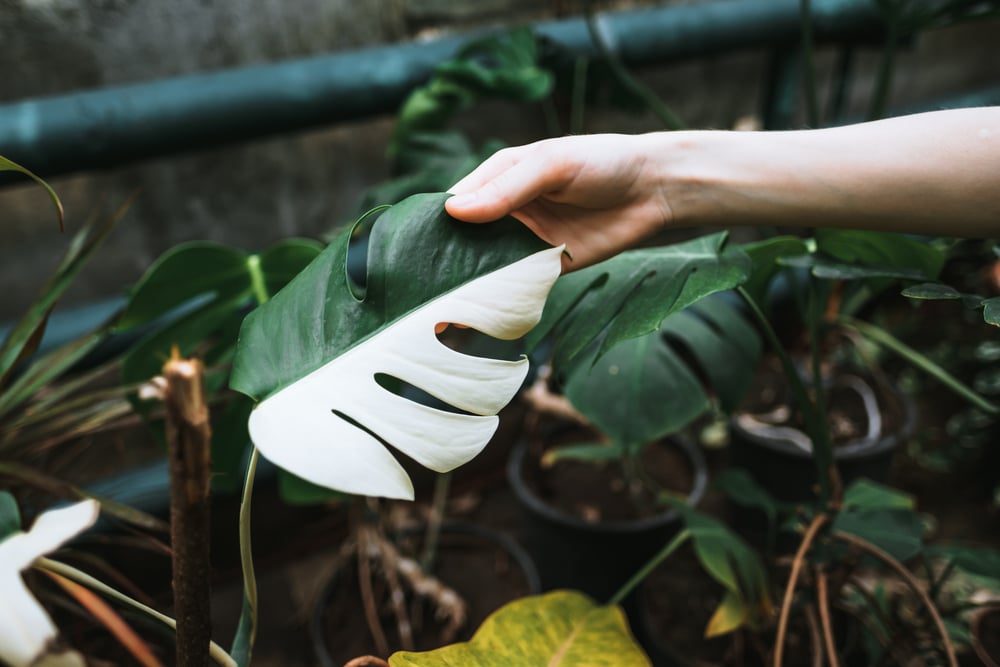
This one is here to stay. People like leaves with some sassy patterns, and the more unique, the better. Variegation gives us visual interest, a pattern to inspect, something to attach the eye to. Many of the most expensive houseplants display this trait.
Holes in the leaves?
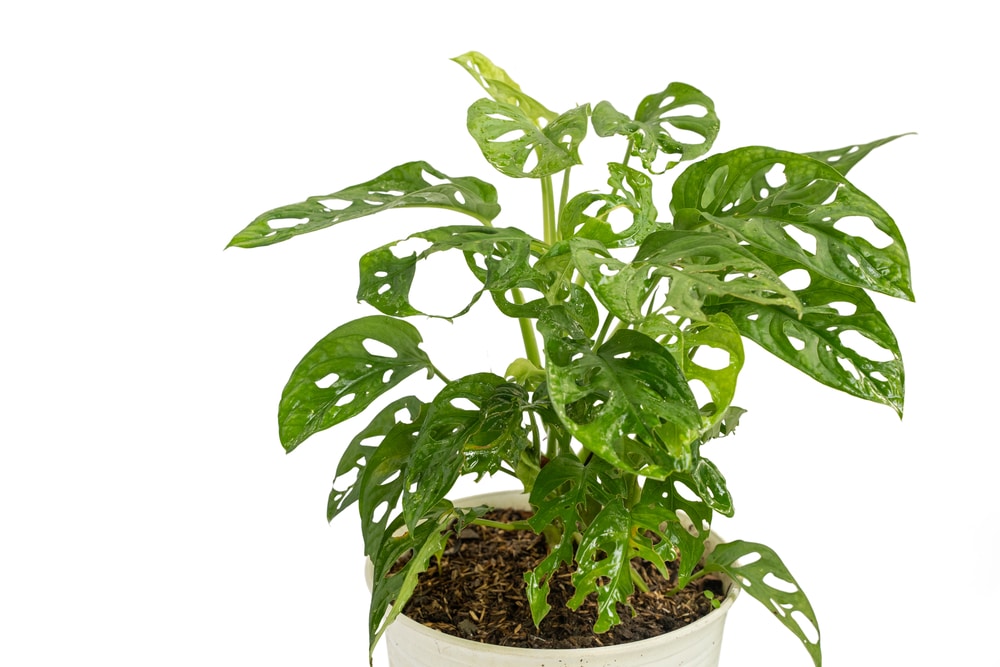
This one is sort of like those jeans we all used to covet that had the holes already in them from the store. Leaves with holes in them are usually a bad thing. Think crunching, munching little mandibles belonging to a host of insects we usually spend considerable effort in keeping away from our plants. Mostly referring to the Monstera spp., the trend for plants that naturally grow Swiss-cheese leaves is hot right now.
P.A.M.
No, not the cooking spray. We are talking plant genera here. The majority of plants currently vying for a spot on the Who’s Who of Houseplants list belong to either the genus Philodendron, Anthurium, or Monstera. All three of these groups of plants fall into the Araceae family.
Most Expensive Houseplants – The List
Here they are, in somewhat rough order of popularity or demand, which is constantly changing. Prices for all can range from affordable to sky-high, depending on size, social media hype, celebrity selfies, and actual rarity.
10. Monstera obliqua ‘Peru’

Often confused with or incorrectly marketed as the more common M. adansonii, this easy-to-grow vining plant has fenestrate leaves, which is a fancy botanical way of saying the leaves have small holes in them. Popular for this striking feature, M. obliqua Peru has climbed in popularity recently and can fetch a pretty price. The leaves are sometimes described as having more holes than leaf or look almost lace-like. Native to Central and South America, it is found in nature growing in the canopy of the lush forests of the region.
9. Anthurium warocqueanum

Sure, you can pronounce Anthurium, but can you say warocqueanum? Well, neither can I. But you can also call this rare but expensive beauty by its common name, Queen Anthurium. Native to Columbia, this Anthurium is known for its striking, long foliage. When grown outside in warm, humid climates the leaves can grow four feet long.
Like many plants from the region, they are climbers and need excellent drainage and bright but indirect light. Somewhat slow growers, they may only need to be repotted every two to three years. These plants earn their place on our list, with most established specimens commanding $150 and up.
8. Philodendron patriciae
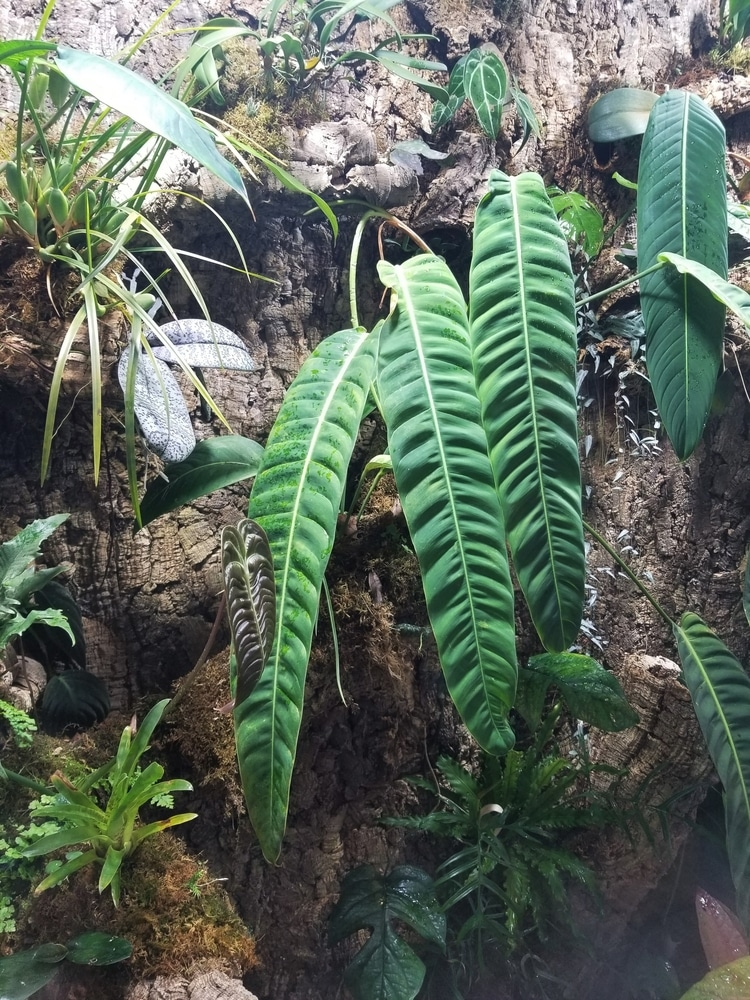
Many Philodendrons could claim a spot on a list of expensive houseplants. P. patriciae, hailing from lush Columbia, is right up there on the menu of highly desired and costly indoor greenery. The leaves are ovate-lanceolate shaped, and hang down as the plant climbs. Check out this illustration on leaf shapes to brush up.
With its long, dark green rippled leaves, gorgeous flowers, and impressive stature, P. patriciae can be hard to find. You may have to get on a waitlist, befriend someone who has one and mooch a cutting, or keep your eyes open at plant shows, but the effort is well worth it.
7. Alocasia azlanii
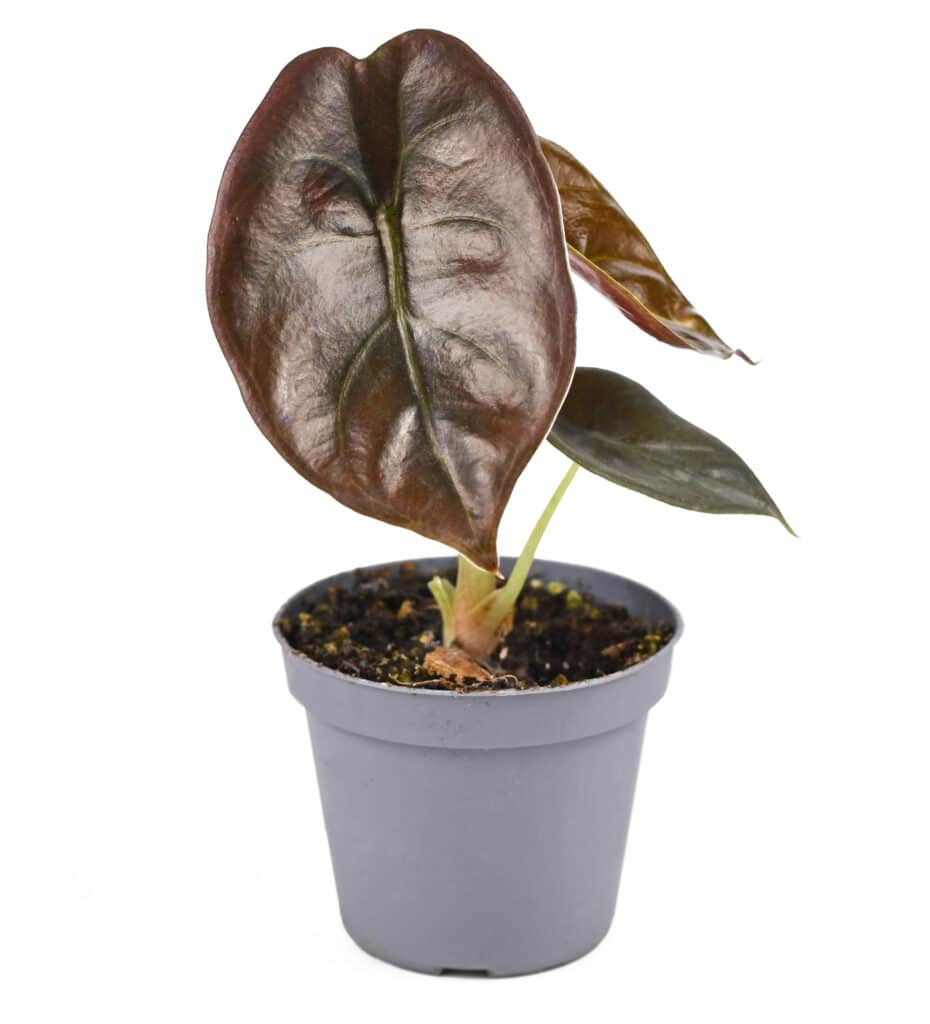
This mid-sized gem hails from Borneo. Also known as Red Mambo or Jewel Alocasia, A. azlanii is unique for the color and texture of its foliage. The leaves on a mature plant are glossy, waxy, and have been described as chocolate-brown, purple, or even bronze in color. If you are fortunate enough to acquire one of these gorgeous plants, it enjoys humidity at 60% or a little higher, and warm temperatures. Give it a well-draining pot and bright, but indirect light and it should be happy.
A. azlanii makes a great focal plant for those spaces too small to be home to a large Philodendron or Anthurium, like a shelf or a desk. It generally will grow to be about two feet tall, somewhat bushy in nature, with leaves less than a foot long.
6. Old bonsai pine
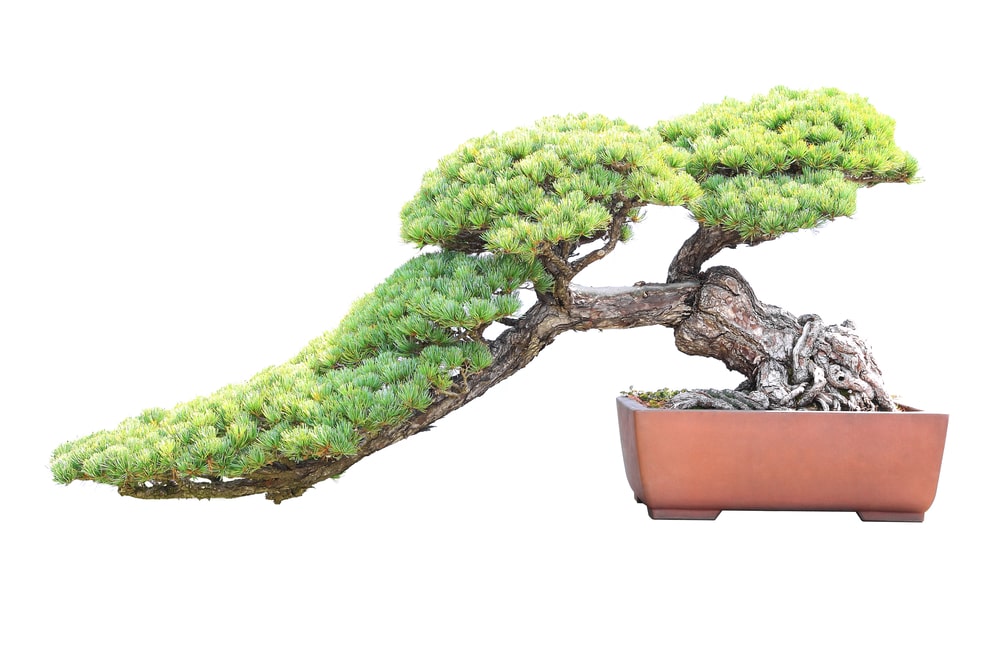
Practice the ancient Japanese art of bonsai without waiting for your seedling to take years to grow. Established bonsai planters come in a variety of plant species, but one of the most popular amongst those who can afford it is an old bonsai pine. These works of art are one of a kind. Adapted from the Chinese practice of creating miniature landscapes over two thousand years ago, the growing of bonsai began in Japan during the Kamakura period.
Ranging up to thousands of dollars depending on age, size, and form, these are truly rare and exclusive additions to your collection. Depending on the species, your bonsai may need to spend part of or most of its life out of doors but can be brought in for display.
Bonsai as an art has many followers and can be done with almost any woody perennial. Most are given names with significance and meaning. Some specimens are over one hundred years old.
5. Monstera adansonii variegated
While regular specimens of M. adansonii are reasonably priced, variegated plants fetch top dollar. The variegation is a popular and rare feature. Lack of chlorophyll in the white portions of the leaves means the plant grows slower and takes longer to propagate, which explains part of the price.
Some variegated plants can lose their variegation if grown under low light conditions, but this does not appear to be the case with M. adansonii. Your regular, green M. adansonii could develop variegation if you are very lucky, but the chances of this are about the same as winning the lottery. If you want that striking foliage, you’ll have to reach deep in your wallet.
4. Philodendron gloriosum
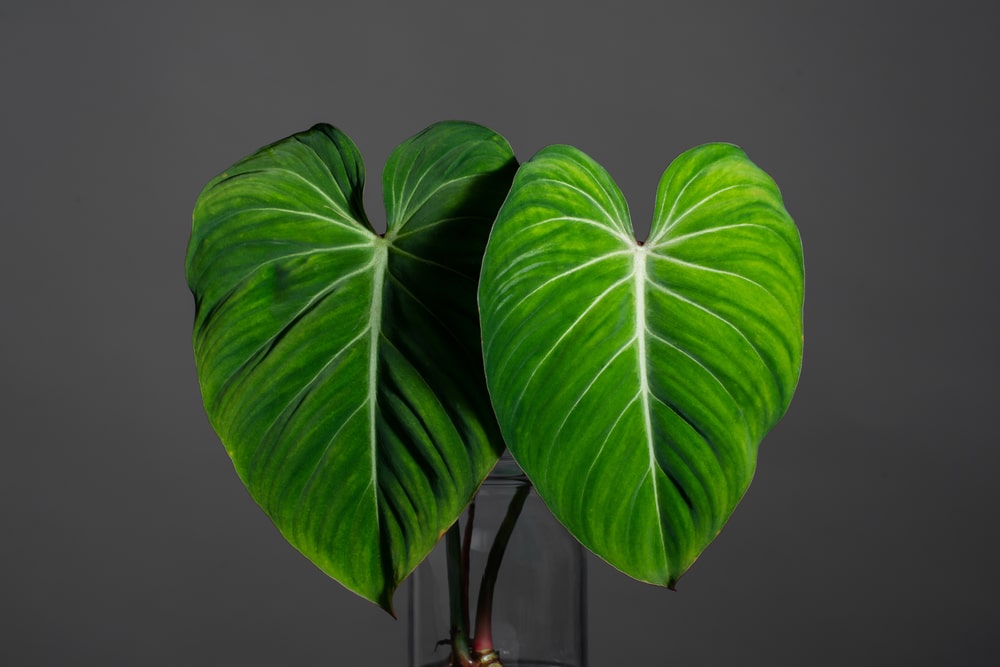
Unlike some of its brethren, P. gloriosum is a terrestrial plant that crawls along the ground instead of climbing in the canopy. It shares the same look of giant, heart-shaped dark-green leaves, often has pale pink margins and white to pale pink venation, and is sometimes claimed to be the prettiest Philodendron. A slow-ish grower, new leaves may take as long as a month or two to fully unfurl.
Being somewhat rare, gorgeous, and in great demand is a good recipe for high prices, and P. gloriosum fits the bill, with well-established specimens topping $100.
3. Ficus lyrata
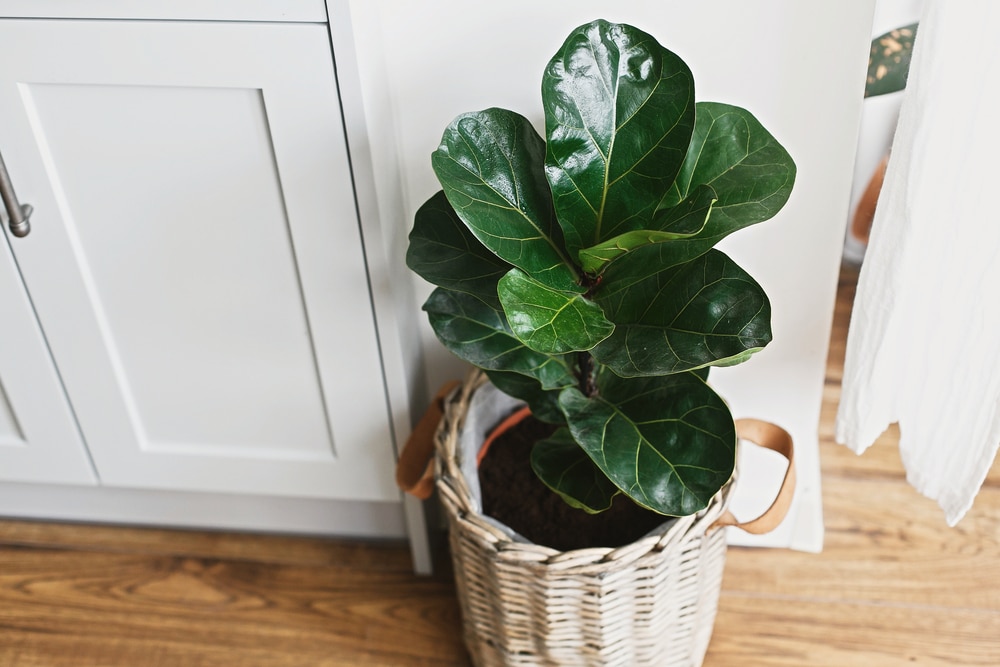
You may recognize this popular houseplant with a finicky reputation by its common name, Fiddle Leaf Fig. Native to western Africa, it can be found growing in lowland tropical forests and may reach heights of 45 feet tall. In a large pot in your house, F. lyrata can be expected to attain six feet tall but may push ten feet in height in time. Mature plants several feet high with a good crown of leaves sell for a pretty penny.
The large, bright green, shiny leaves and upright growth make it popular as a statement plant. Keep it well watered, but not overwatered, and in an area with bright, filtered light. This plant is toxic to cats and dogs. Mine is a bit particular, and will petulantly drop a leaf if I scowl at it or happen to say a cross word in its presence.
2. Philodendron billietiae
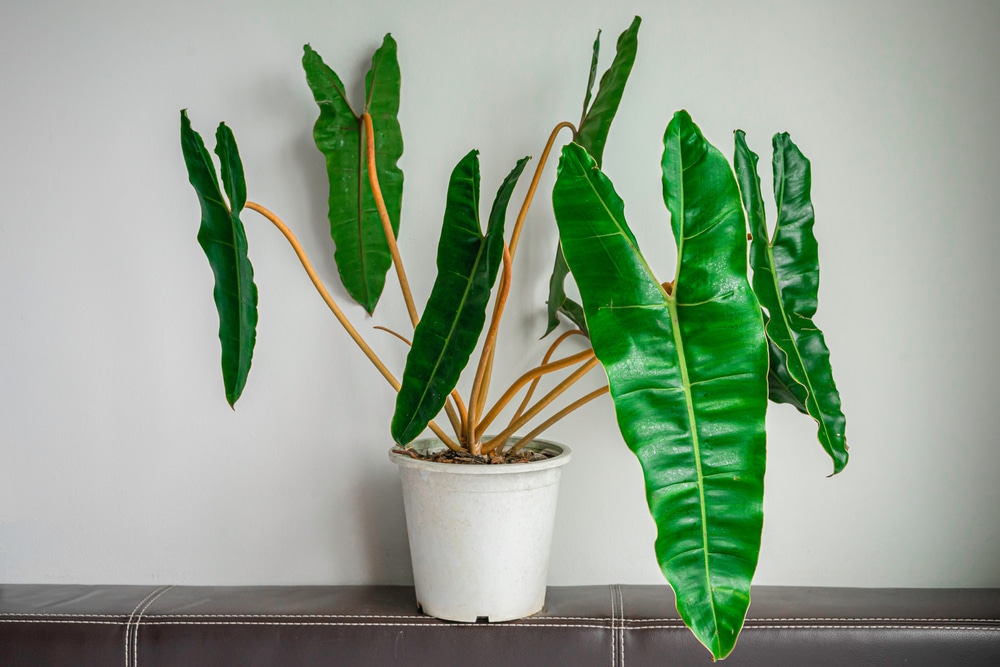
Somewhat similar in form and shape to P. patriciae, this Philodendron also commands premium prices. It was just discovered recently, in 1995. The real sticker shock, however, is when attempting to buy a variegated variety. Depending on the amount of variegation and patterning, established individuals of P. billietiae variegated can command prices into the thousands of dollars. In high demand, these tropical plants are often snapped up whenever they show up at a local exotic or tropical plant seller.
1. Philodendron erubescens ‘Pink Princess’

The current darling of the expensive, exclusive, and elite houseplant collector, P. erubescens ‘Pink Princess’ shows up on nearly every list of expensive and desired indoor plants you can find. Climbing vines and bright pink variegation make this plant stand out in any company. The bolder the pink color and the more of it, the higher the price climbs.
Buyer beware: a Philodendron with some leaves completely pink is may be a different variety, usually called Pink Congo. The leaves are artificially colored by injecting chemicals directly into the leaf. Normal green coloring usually returns within a year. Pink Princess will have variegated pink leaves.
Like most Philodendrons, Pink Princess will want excellent drainage, bright indirect light, high humidity, and warm temperatures mimicking its home in Columbia.
The Next Rising Star?
So, if demand and fame drive price, how can you score the next trending houseplant before the masses want it and the market explodes? Which plant is on its way to becoming the #houseplant star of 2022?
We at Just Houseplants dug out our crystal ball and polished it up. The result for the next upcoming high-demand–and therefore expensive–houseplant: Platycerium bifurcatum, otherwise known as Staghorn fern.
A 26-year-old Staghorn fern was recently featured on Magnolia. Ferns were already a hot commodity, and “Earle”, as this one is named, is featured in the store and on the blog. Anything Joanna Gaines touches becomes a hot trend, and this fern may be the next big thing. Unique foliage and a celebrity endorsement–get it while you can, you heard it here first.
Have any suggestions to include on our list? Have an insight into the next hot houseplant? Drop us a comment below!


I love your selection of plants. I’m getting 2 that are on your list and I’m going to use Eco Dripper to prove I can get the optimal results.
Thanks